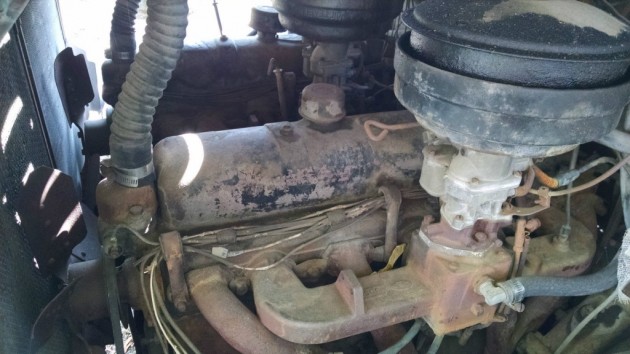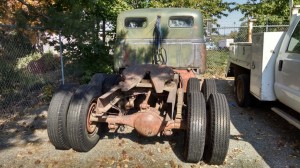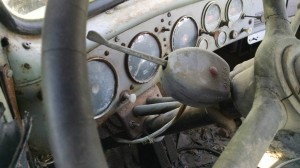Matt K found this old semi tractor is listed on eBay in Spokane. Thank you Matt for finding this unique old truck! It looks like a lot of old trucks that have run out of road, but this one is truly unique. The builder was certainly ingenious when he designed and built this unique rig. It has not run in awhile, but the engines (engines?) are said to be free and the rig rust free except for surface rust.
Do you see something odd here? Yes, those are two big GMC 302 sixes. Each has it’s own separate drive train, one gas pedal for each engine. Each engine drives it’s own axle through a two speed rear end.
It was built on an extra wide frame. The drive shaft for the real axle goes over the front axle. This configuration must have kept the driver busy. How do you drive something with 2 gas pedals, 2 clutch pedals, 2 brake pedals and 2 shifters? What would someone do with this rig? It was said to have been driven successfully. Will it drive again?







Now that’s what I call doing things the hard way!
During ww2 they used a lot of dual engine trucks.
But not side by side that I know of.
Hi Turretman, this Ford type was used as a military transport truck in the states during the war. Again, not too successful. http://assets.blog.hemmings.com/wp-content/uploads//2010/03/dualmotors_resized.jpg
Wow, thanks for that link. I’ve been aware of those trucks for some time but have never seen a pic showing the engine placement, only shots of the front.
From what I have read, those trucks were used to transport bomber sub-assemblies (the wings I think) from the supplier to Ford’s Willow Run plant for final assembly. That truck required two drivers however. One steered and drove the left engine, the other only had to handle the right engine.
Interesting that the engines are much farther back than normal COE placement. I now want to see the trans shift linkage. A very long reach indeed.
After my first reply, I did a google image search and I see that there were several configurations. I’m not sure this was the truck used by Ford for bomber sub assembly runs. Other photos show conventional tandem axle trucks that are more likely the ones Ford used. In fact there are several color shots of the tandem axle trucks, one or two in the company of bombers which suggests at least one has survived.
Still an interesting truck with the side by side flathead v-8’s and the two single wheel axles in line with each other.
Another solution to the problem was the Ardun heads for flatheads. Originally commissioned by a trucking company in England as a solution to the tendency of flatheads to crack the blocks when used to carry heavy (high duty cycle) loads.
Link to the image search https://www.google.com/search?q=ford+twin+flathead+transport+trucks+world+war+2&espv=2&biw=1600&bih=731&tbm=isch&tbo=u&source=univ&sa=X&ved=0CBwQsARqFQoTCP3JzKPx-8gCFUJ7PgodWvMGow
A real ‘Twin Six’. None of your exotic V12s here! And once up to cruising speed, on’
level ground, could you shut off one engine?
I think the guys father fed him a load of B.S. On the “success” of his engineering brainstorm thus the reason the old guy never restored it:). Hate people who write ads in all caps!!
Talk about multi tasking this thing would be a handful to drive, definitely a distracted driver truck.
I tend to agree with Leo, although a little harsh, I don’t think it was all that successful. We have to remember, back then, long distance trucking was gaining steam, and unfortunately, trucks were not keeping pace with the demand, and all sorts of solutions were on the drawing board, including 2 engines. Kind of a carry over from the military, but there were better ways, Diesels were clearly superior, but many were unfamiliar with diesels, and chose to stick with gas jobs.
While the ingenuity is pretty cool, history has shown, 1 big engine is much better than 2 smaller motors. Here’s another attempt, a Diamond T with a Buick V-8 to assist the IH 6 cylinder. Again, not too successful.
http://assets.blog.hemmings.com/wp-content/uploads//2014/09/twinengineDiamondT_2500.jpg
Hmm, that’s a real oddball. With two engines I’m surprised to see it is only a single axle though. That doesn’t suggest it carried (or had to pull) a lot of weight.
Hi z1, apparently, it was a tandem axle, and when it was restored, the rear axle was left off. Btw, I know 1st hand, those grain loads can get pretty heavy ( hence the need for more power) http://assets.blog.hemmings.com/wp-content/uploads//2014/09/twinengineDiamondT_600.jpg
I found an advert for an early twin engined American car. The advert stated that two engines were better than one; ask any ship’s captain.
Surely you’ll share the ad!
This thing is straight out of the new mad max movie. I’d bet I could rig up something that could make this a bit easier to drive. Hand operated clutches to disengage each engine and lock them in that state. independent starters and shifters… actually no. This really needs a planetary and single transmission.
I was thinking a remake of Spielberg’s classic, ‘Duel’.. :D
Thats not two motors —its a big nail head
In the ad, the seller notes that the transmissions are dual-range automatics. I don’t know how such a transmission works, but it seems that clutching and shifting, at least, has been removed from the equations. Still seems like driving this thing would require three feet though.
I do wonder how much of the dad’s story was hyperbole. Maybe Junior was taken in by the old man’s tales of derring-do. But regardless, this is still a really cool old truck.
The writeup says that the drive train was from a military 6×6. That would be either an M135 or M211, probably the latter since it’s got dualies. This, from Olive-Drab.com explains the high points.
“All trucks of the series were equipped with 6×6 drive, powered by the GMC 302 6 cyl in-line, valve-in-head 130 hp gasoline engine. The M135 was equipped with 11:00×20 tires with singles on the rear while all other models had 9:00×20 tires with doubles on each rear axle. The transmission had four forward speeds in two speed ranges. All the driver had to do was select the speed range. The transfer case was single speed, but a lever allowed it to be put into neutral. The axles were full floating hypoid single-reduction type with banjo housings. Front and both rear differentials were interchangeable.”
I also found the description interesting about using the engines independently to change ranges when climbing. No drift-back in speed.
I re-read the writeup. As for pedals, I can imagine from the photos operating both accelerators with 1 foot and the description of the brake setup suggests both feet on them. There was no clutch.
I suspect you could run at fair speed with one engine idling in neutral or on a hand throttle (very common).
And yes, having time and money I’d love to bring it back to life.
Don’t forget that TV Tommy Ivo successfully built and raced a number of two and four engined dragsters in the 1960s and Citroen built the twin engined 2CV Sahara model as well as a regular production model.
“TV Tommy Ivo”